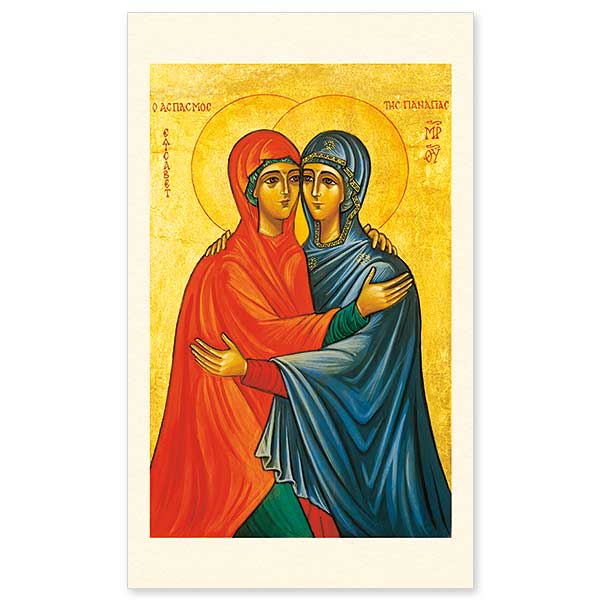

| Cards as shown (No Imprinting) | |||||
| Item Number | Description | Price Each | Quantity | Total | Action |
|---|---|---|---|---|---|
| PCM507 | Package of 25 icon holy cards |
$8.50 |
package |
$8.50 | |
| Item Number | Select Imprinting option: | Price Each | Quantity | Total | Action |
|---|---|---|---|---|---|
| Not Selected |
|
|
cards 30 piece minimum. |
In “The Visitation" Mary embraces her kinswoman Elizabeth, as the prenatal John the Baptist leaps with joy and recognition within Elizabeth’s womb. (Luke 1:39-56) “And Elizabeth was filled with the Holy Spirit and exclaimed with a loud cry, 'Blessed are you among women, and blessed is the fruit of your womb.'"
Icon holy cards are 3" x 5", a convenient size for use as gifts or bookmarks. The backs are blank except for a faint colophon at the bottom, leaving plenty of room for custom imprinting with your own message.
In those days Mary set out and went with haste to a Judean town in the hill country, where she entered the house of Zechariah and greeted Elizabeth. When Elizabeth heard Maryís greeting, the child leaped in her womb. And Elizabeth was filled with the Holy Spirit and exclaimed with a loud cry, "Blessed are you among women, and blessed is the fruit of your womb." (Luke 1:39-42) This familiar story in the Gospel links the nativities of John the Baptist and Jesus. The event has been celebrated by the Church for centuries as the first miracle wrought by Christ while still in His motherís womb, using Maryís mediation to bring grace to St. Elizabeth and her unborn son who would become John the Baptist. St. Bonaventure first recommended celebrating the event with a feast in the Church calendar, and this was begun by Franciscans in 1263. The practice spread to the entire Roman Catholic Church in 1389 and continues to this day. An order of nuns, the Visitation Order, was founded in 1610 by St. Francis de Sales and St. Jane de Chantal. Today, they number about three thousand sisters in 168 monasteries around the world. Most follow a cloistered life-style, but some add various apostolic ministries to their contemplative work.
This simple composition focuses on the greeting embrace of the two women, St. Elizabeth in the red cloak and Mary in the blue. They are surrounded not by scenery but by a background of gold leaf. Gold, because it reflects light differently from pigment, is used in iconography as a symbol of Divine Light. The inscriptions on the background are Greek and read from top left; "The Greeting," "Elizabeth," "The all-holy," and "Mother of God." Saints are frequently labeled in icons so that no confusion can arise about who is being portrayed.
The icon has an elevated border. Many ancient and some modern icons have a recess carefully chiselled out of the center of the board before the underlying gesso is applied and the image is painted. While this adds a certain decorative appeal as a built-in frame, the primary purpose is practical. The recess protects the image from damage when the icon is stacked with others, and it supports a hand rest consisting of a flat piece of wood laid across the image while painting fine details.
Maryís cloak, called in Greek a homophorion, has three stars on her head and shoulders. They are symbolic of her perpetual virginity; before, during, and after Christís birth. The gold embroidery around the face reflects her special importance as Queen of Heaven and Mother of God. Halos surround the heads of Mary and Elizabeth and these are symbols of their sanctity. Both womenís faces are painted in iconographic style, with little attempt at realistic portraiture. The noses are long and narrow in the Byzantine ideal of nobility. The mouths are small and closed in the silence of spiritual contemplation. The eyes are overlarge windows to the spirit. Neither saint makes eye contact with the other or with the viewer. Their gaze is within or toward the infinite.